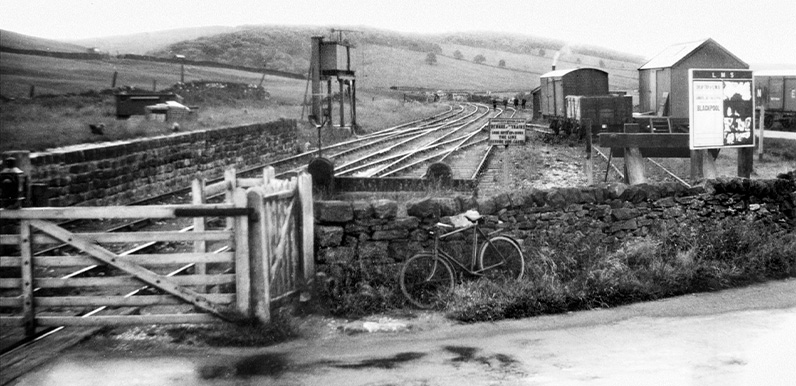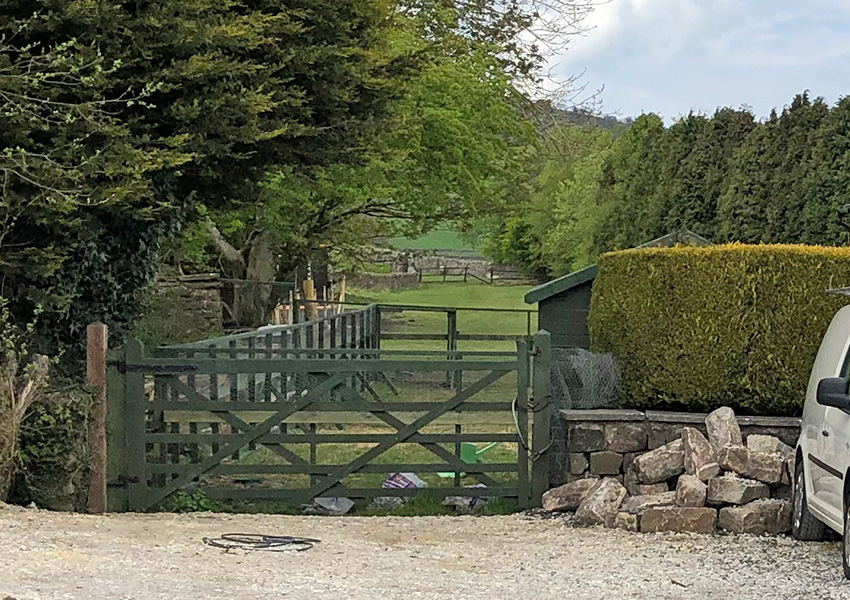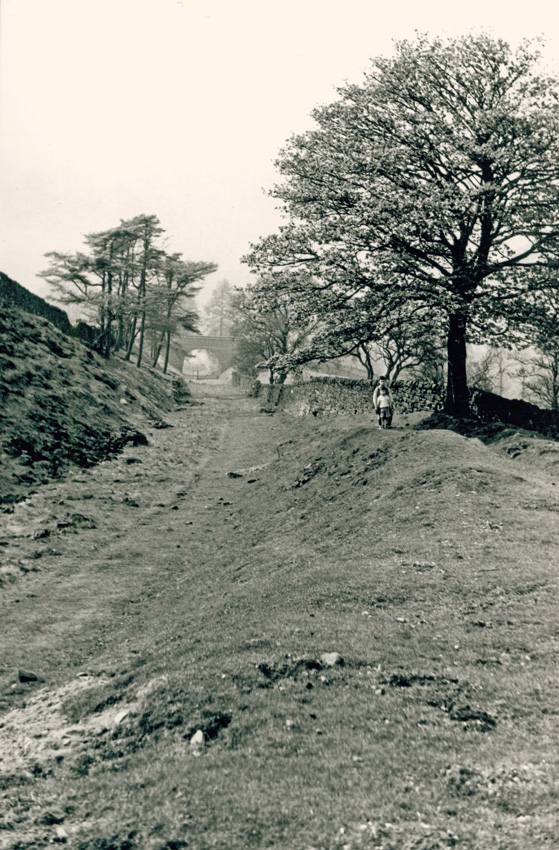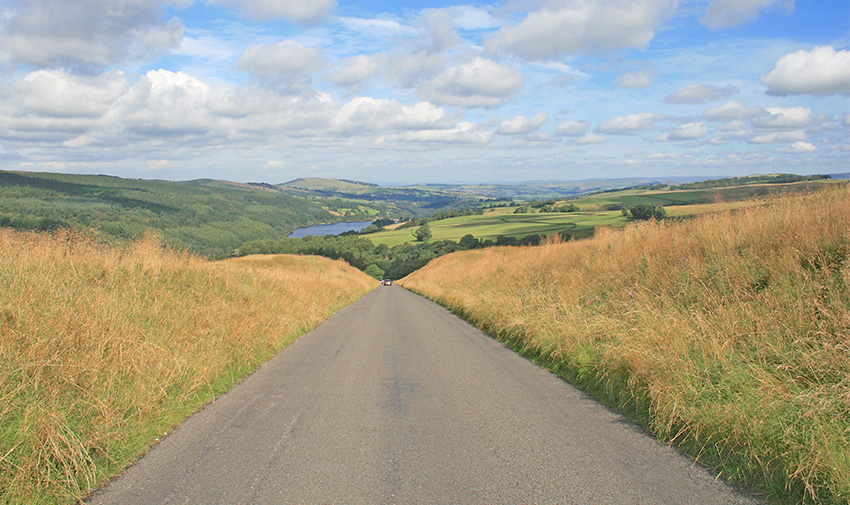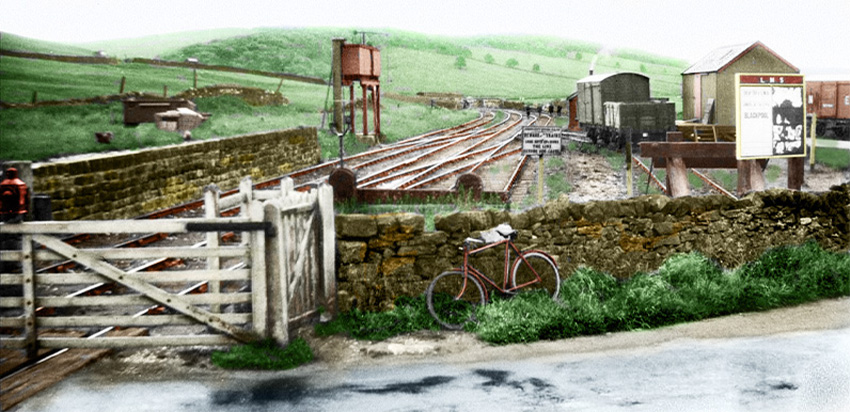Above: Ladmanlow goods yard pictured in 1932, looking north from the A53 Leek Road. This is likely to have been the ‘Park Gates’ the writer describes.
Passengers were not allowed following a fatal accident in 1877. The yard finally closed in 1954.
Above: This is the same view today (click to enlarge). The tracks and buildings have long since gone, although I’m told that there are still some remains, including railway buffers.
My thanks to David for pointing me towards this post on his Furness Vale History Society website about the Cromford and High Peak Railway. Which at one time ran through the Goyt Valley, all the way to Whaley Bridge. The first article was published in The Derby Mercury on January 1883 and describes one of the last journeys taken by a passenger on the line, aboard the ‘Fly’ carriage.
It was in August 1877 and thinking I should like to see the country through which it passed, I went to Stonehouse, generally called “Stonnis”, just by the Black Rocks where the railway crosses the Wirksworth Road and enquired of a man in the office for the train.
“Do you mean the Fly” was the reply, “Yes”, but the official, not knowing whether the “Fly” had passed or not, went out to enquire and brought back word that it had gone, but that if I followed it up the line, I might catch it at the siding; and if not, I should be sure to overtake it at “Middleton Run”.
I accordingly gave chase, and at length caught sight of it being drawn up the incline by a rope and a stationary engine. A man at the bottom enquired if I wished to catch the “Fly” and added, “I will stop it for you at the top”, which he did by a signal. A quarter of a mile ahead I joined it.
My fellow travellers were then a young woman and a child, and the vehicle on which we sat was like an old omnibus. The guard stood in the middle and worked the brake through a hole in the floor.
A locomotive now drew us three or four miles to the foot of another incline, up which we were drawn by a rope. When reaching the summit, the guard remarked, We may have to wait at the top.
“How long?” I enquired, “Oh it may be five minutes” he replied, “or a few hours”. It all depends upon when the engine comes to take us on. “Yesterday”, he added “It did not come at all”.
To while away the time, I walked along the line and my fellow passengers went mushrooming. In about three hours an engine came from Whaley Bridge to fetch us, and after the driver, fireman and guard had refreshed themselves at a little public house not far away, and had freely commented on their “horse”, they went back along the line, brought up the “Fly” and having refreshed themselves again, we started.
At one part of the journey a flock of sheep were quietly feeding or resting on the line. “Just see them” said the guard as we approached, “jump the walls; and they did it like dogs. We reached Park Gates about a mile from Buxton at seven o’clock after a journey of about twenty miles in six hours.
Not long after my journey, a passenger on this line was killed and the company decided to close it against passenger traffic.
*My thanks to John on the Lost Cromford & High Peak Railway Facebook Group for helping me work out a few details I wasn’t sure about.
The writer started his journey at Steeplehouse Station – not Stonehouse – which was at the top of Middleton Incline, just outside Cromford.
John thinks ‘Park Gates’ was Ladmanlow Station, as it was the closest to Buxton. From here to Whaley Bridge, the line descending three steep inclines; Bunsall, Shallcross and Whaley Bridge.
John explains: “Bunsall, which was in two sections, was worked by stationary steam engines, as was Shallcross. The Whaley Bridge incline was worked by a horse gin. Locomotives worked the level sections between the inclines. Passengers had to walk up and down the inclines.”
Above: The Bunsall Incline before the construction of the twin reservoirs (click to enlarge). It was tarmacked in the 1960s.
Over iron roads
An extract from a book by F.S. Williams
Above: The Bunsall Incline was the steepest section of the route, with trains being hauled up and down using steam-powered winches. Today it forms the main route into the valley from the Buxton to Whaley Bridge Long Hill road.
The Derby Mercury of 1st Jan 1890 in writing about the Cromford and High Peak line noted that “it is hardly up to the level of modern requirements. It has gradients of one in 7½, one in 8½ and one in 10½ worked by stationary engines, and more remarkably yet, at one point a gradient of one in 14 worked by an ordinary locomotive.
The train load at this point is fixed at one truck. Sometimes with a good run to start with, engine and truck get to the top of the hill; sometimes they do not. In this latter case, the brakes are screwed down and the train slides meekly back to the bottom of the incline and has another try.”
The passenger train on the Cromford and High Peak was never busy. In 1861, just 161 passengers were carried and the service ended in 1877.
Parsley Hay station, near Hartington became part of the Ashbourne branch and re-opened in 1894. The three passenger trains per day were withdrawn in 1954.
Parsley Hay station featured another eccentricity as reported in a 1908 newspaper. The signal and point levers and block instruments were housed in the booking office and one of the waiting rooms featured a harmonium and seats for it also served as a mission hall.
Later photos show a signal box so perhaps this was a later modernisation.
There are a few posts on the website about the C&HP Railway, including this more detailed report of a journey along the entire route in 1880. And this one on Ladmanlow Station.
Above: David created this colourised version of the 1932 photo of Ladmanlow goods yard (click to enlarge).
